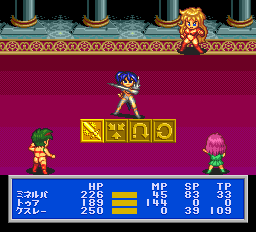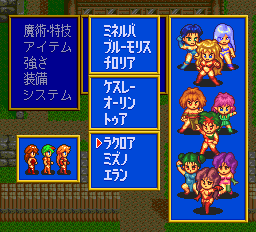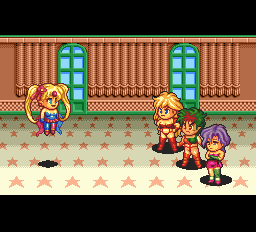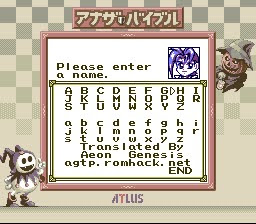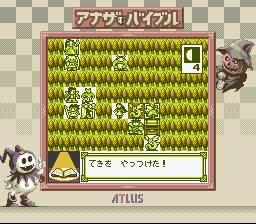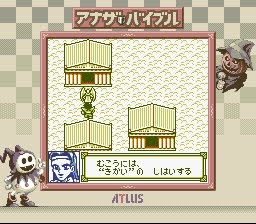As usual for the Super Robot Taisen games, I’m pasting my old forum comments from 13 years ago, so this will not be the usual kind of post.
Overall this is the best of the SRW games for Super Famicom and I think it has an impressive amount of content for a game of this era. It still can be quite difficult if you try to play it without any walkthroughs or help, and the system is still fairly rough compared to later SRW games. But if you like this era of SRPGs I would definitely recommend it.
===================
SRW 4 (Dai-4-ji Super Robot Taisen)
Super Famicom, 1994
===================
SRW 4 came out about a year after EX. After you beat each route of EX it says the story will be continued in 4, so they were planning it at that time. This represents a huge leap from 3 and EX, and is the pinnacle of SRW on the SF (not counting the Gaiden game) [Kurisu 2020 note: I now think Gaiden (Masou Kishin) is not as good as SRW 4].
All the series from 3 and EX reappear, with the addition of five new series: Zambot 3, L-Gaim, Dancougar, Daimos, and Shin Getter Robo. There are over 250 characters in the game.
The changes from EX:
– FINALLY you can choose on a per-attack basis whether to dodge, block, or counter.
– You can now upgrade the mobility of a mech.
– Pilots now have two states, shooting and melee, and the weapons are separated into those types.
– You can equip items on a mech, although items are found on secret spaces on the map rather than from defeating enemies.
– Barriers (I. Field, etc.) now stop only certain levels of damage, not any attack like in the previous games.
– The pilots have skills now like Newtype and Sword Cut.
– The storywriting is much better; the character development is integrated with the plot better, the plots from the anime are used more overtly, and there are more factions with individuality.
– You have a customizable original main character.
– You can now see the damage you do to enemies over 10,000 HP, and when you drop them below 10,000, you get to see their true max HP.
– There is a character and robot dictionary in the options menu.
– The system where losing an ally changes people’s morale based on their personality is added in this game (always makes a bigger difference on the enemy side).
– You can no longer see the enemy stats until you fight them once.
– The designers started to think more about the seishin and match the seishin to the character’s personality. New seishin were added as well.
– Some units (like Combattler) can now separate and combine.
– The difference between Real and Super robots really increases in this entry. This is the first game where the game actually mentions “real” and “super” in the game, and there are specific stages for each. Also, with the introduction of the Mobility stat for mechs, the difference in dodging between a real and super robot is much more extreme than it was in the previous games. The size modifier hit rate also enters the game with 4, which adds to this.
Stage 1 – The Beginning
I took Ring with the magic 9/2 O birthday setup. Real Robot.
Interestingly enough, in this game, DC and Neue DC are different groups. Here you get attacked by DC. This is a pretty good starting map; there’s a 10000 gold spot in easy reach (Fa is a good item getter), two items, and two bosses with good money if you use Luck. I was able to beat both Brocken and Ashura (Brocken flees at turn 6) and beat the stage in 5 turns. I made 43,000 so that’s pretty good for stage 1 (I think for the first time ever I actually used Boss’ explosion seishin to hit 4 guys at once).
Where you go for stage 2 is determined by the turn count here; I finished under 7 so that I can get the L-Gaim units earlier.
Stage 2 – Mysterious Visitors
Heavy Metal L-Gaim enters the SRW franchise.
Of course, they have the great beam coating (which is so frustrating on the enemies)
If you didn’t beat the previous stage in 7 turns or less, you don’t get the L-Gaim units until a little later. The Titans also make their first appearance on this stage.
I wonder if it’s possible to beat Hardias, who runs at turn 5. I think it might be, if you spend all your money upgrading Getter Beam and send every unit towards him as fast as possible. Even then it might not be, though.
Stage 3 – A New Enemy
First Heavy Metal stage. It’s somewhat hard, although most of the enemies don’t have the beam coats. You can end the stage more quickly by going after Gablae first, but that might actually make it harder. There are also a lot of good items on this map.
Stage 4 – Special training! Daisetsuzan Oroshi
Unlike the other path, this stage has only the Getter Robo and Texas Mack. Ashura’s Bood gives good money so I defeated him with Mack instead of Getter (Mary King has the Luck seishin).
Stage 5 – Bright’s Return
This is the “save the medeas” stage; it’s much, much easier than the one in SRW F. If you just take your fast guys up to the top (use Speed) and leave slower people down at the bottom to deal with the reinforcements, it shouldn’t be too much trouble to save all three. The Dancougar pilots join in this map — the four pilots and Hazuki (I think) are the only Dancougar people to show up in this game; even Shapiro does not appear.
Stage 6 – Stampede
Interesting stage. The Dragonasarus has gone berserk and you have to kill it before it reaches a town. The Titans help you out a bit, and the main character’s love interest appears. The Dragonasaurus is most easily defeated by luring it onto land (just don’t let it touch the city) and then kill it. The problem is Ashura’s Bood. Ideally you would want to kill both the Bood and the D, but if you kill the D, Ashura retreats. The problem is that Getter 1 is the most effective robot to attack the D (because once it wastes a few shots, it can’t attack flying units), but you probably won’t be able to beat the Bood without Getter 3. I didn’t want to waste too many turns so I just went ahead and took out the D, but you might be able to plan it better.
Stage 7 – Fighter Daimos
As the title suggests, Daimos enters the SRW franchise.
I’m disappointed that F removed Daimos from the lineup (they also took out Zambot 3 and the Daitarn 3 enemies…not Super Robot fans, I guess.) Here’s Richter and Koros from Daitarn talking — this is also a rare instance of Daitarn’s enemies appearing in the game:
Stage 8 – Love of the Battlefield
Everyone’s favorite stages — Heavy Metal enemies. I upgraded my super robot attacks pretty well so this wasn’t too tough. Thankfully the beam coats now do not offer complete protection so Amuro in the Re-GZ can kill enemies with hot blood.
Stage 9 – Zambot 3 Appears
Zezenan talks to Koros to make an alliance with the DC:
Zambot 3 is a rare appearance in SRW; I think aside from 4 it only appears in Compact 2/Impact, but I could be wrong.
Stage 10 – Sorrowful Memories
Sara is here, but Scirocco is dead — some continuity from 3. It seems like they were a little more careful with the 3/EX->4 continuity than they were with the 2->3 (F torpedoes it all, though).
Stage 11 – Awaken, Dancougar!
Title tells it all. Dancougar sucks in this game for the most part; it can’t fly, it doesn’t have the Beastly ability, and you have to choose between Combattler V and Dancougar (allegedly because of space issues on the save file).
Stage 12 – Guyzock’s Terror
Roph appears here talking to Butcher:
Guest seems to have their hand in the whole pot much more than in F, although I haven’t seen the end of FF yet.
Defeating Butcher here before turn 8 changes events later in the game; I just used upgraded super robot attacks, and finished him off with Ring:
Stage 13 – Surfacing
Dunbine appears.
Stage 14 – Mazinger, flying in the sky
Gilliam shows up here, and strangely gets Neppu! Shippu! Cybuster as his theme instead of Time to Come.
Stage 15 – Miia’s Decision
The Combattler V plot is introduced and finished in two stages; quite abrupt. Although most of this map is Richter attacking you, using all DC forces (I guess the “alliance” was more Richter joining DC). Also, after this map is the first instance of technical limitations of this game; apparently there were problems with the size of the save file, so in a few cases you have to choose between characters. Here you have to pick Nana or Kyoushiro, not a huge problem.
Stage 16 – Great General Garuda’s Tragedy
Here’s the end of the Combattler V plot (again). Most of the map is just fighting DC; in F they at least allow this to be a whole stage to give Garuda some dignity.
Stage 17 – The Expansion of the Aura Battlers
You get one of the Dunbine battleships in this mission depending on whether you have Galaria or not (you get a better one if you don’t have her; I should have killed her). Then it’s more Heavy Metal enemies, but they’re not too bad if you’ve upgraded Super Robots enough.
Stage 18 – Intruder
You have 6 turns to get to the base. Some people like to hang around until turn 6 and beat as many enemies as they can; I just rushed Amuro to the base in 3 turns. The Guest units appear here:
The treatment of the Guest is interesting in 4; they take a long time to show up, but the heroes seem to immediately connect them with Inspectors way before they even know what’s going on (as early as stage 1 or 2). In F, Zeb and Seti show up (and call themselves “Guest”) pretty early, but nobody seems to connect them with the Inspectors or even mention that as a possibility.
Stage 19 – The End of Baron Ashura
I sort of took a cheap way out on this stage. Once you beat Ashura you have 6 turns to get out of the base. What I did was just take Getter 1 and the Gespenst over to Ashura and kill him, and then let the enemies destroy both units to save turns (for some reason if you get defeated then you don’t lose the map — this would be much harder if the condition was to leave the base in 6 turns and nobody can get killed).
Stage 20 – Elegy for an Old Soldier
This is kind of a tough stage; there are a lot of MS enemies with high mobility (the super robots have a much tougher time hitting them than they did in EX and 3). I used Shou in the Zwarth as a decoy; he’s even better here than in F because Hyper Aura Giri is free, and the Zwarth has HP recovery. Sara joins you on this stage if you convince her with Katsu.
Stage 21 – Dr. Hell’s Ambition
Sharkin returns after being defeated in 3; they make a point to say in the dialogue that he was already defeated (and Garuda). I don’t know if they’ll explain this — my guess is that all this bizarre activity will be explained due to Guest at the end, but we’ll see.
Stage 22 – Turning Point
This is a quick and easy stage; not much to say about it. Afterwards you get to choose space or Earth; I want a change of pace so I took Space — we’re going to stop Neue DC from dropping a colony on Earth.
Stage 23 – Into Space
I thought this would be a hard level, since I was left with a lot of unupgraded and low level units; it was tough but I managed to do it just in time on turn 10. My guys levelled up quite a bit from this fight. (I had Amuro in the Z Gundam, which helped a lot. Kou was in the Re-GZ; he sucks horribly, as usual.)
Stage 24 – Meeting with AEUG
Quattro and Grendizer come in here.
The plots of 4 and F are such that listing the similarities would be easier than listing the differences, but in very very rough terms, this is the point in the story that SRW F reaches. (It’s interesting that this is over halfway through 4, but only a little over a 1/3 of the way through F/FF combined.)
Stage 25 – Assault! Limit Intervention Point
You just have to get Bright to the colony to stop it, but I destroyed all the units on the map. Go me.
You also get help from some AEUG units, including the great Ball:
Stage 26 – Londenion
Lots of new units here; the Nu Gundam and the L-Gaim Mk II. This is also the first appearance in SRW history of the Huckebein:
It’s kind of odd to see the Huckebein as the most powerful unit instead of one of the least powerful.
Stage 27 – Granzon’s Enigma
The stage itself is unremarkable, but afterwards the backstory of Shu and Masaki is developed a lot (I assumed a lot of this development would be in EX, but EX hardly has anything). Granzon is built using Guest technology, and Masaki mentions an event a lot like the one in OG1 when Shu causes the disruption in the Guest/Federation alliance. At this point you still don’t really know what Guest is, though.
Stage 28 – Neue DC
Everyone’s favorite pink-haired villian shows up here:
But you make peace with Neue DC so no fighting. This is mostly a Goshogun stage.
Stage 29 – Mars Connection
Lots going on here. You have to fight three waves of enemies — first DC, then Guest, then L-Gaim. I made sure to head directly for the city so I could be there, and I used map attacks alot. Unfortunately I lost my battleship and had to pay 60,000(!) for repairs…ouch.
This is the first chance to fight one of the Guest bosses. But why worry?
Their difficulty is way, way overrated.
Looking forward a bit, there are three possible L-Gaim final stages. People mentioned on an older thread that the hard ones are some of the hardest stages in any SRW game, so I will try to avoid those. To do so, the first thing you have to do is convince Olibee with Daba in this stage (RR only…if you are on the SR route you automatically get the hardest Poseidal stage at the end.)
Stage 30 – Koros and Don Zauser
You come across the other Masou Kishin characters here, but they leave to chase after Shu, and you get a pretty generic fight.
Afterwords, Koros reveals herself as the leader of DC. This section shows the older style of SRW writing — Banjo mentions that his father created the meganoids but this is just sort of a throwaway line; nobody reacts to it or mentions it again.
Stage 31 – Storm of Kilimanjaro
This is a rare “sky” stage in SRW, where you can only send out flying units.
Stage 32 – The Day of Dakar
You have a choice here — have Blex killed and lose Quattro, or keep Blex alive and keep Quattro. If you lose Quattro, you can get Gato and the Atomic Bazooka later. I chose to lose Quattro because he’s in a lot more games than Gato is. This stage has a lot of interspersed story in it; much more like the later SRWs.
Stage 33 – Total Balance
A Dunbine stage. There seems to be a split within the Aura Battler enemies.
Stage 34 – A New Power
This is the final Guyzock stage (if you killed Butcher earlier so he couldn’t abduct the kids). You can beat it in 3 turns or so by sending the Huckebein at max speed and then hitting Butcher with Miracle + fully upgraded Rip Slasher a few times.
Stage 35 – Singularity Point Collapse
This stage contains the big backstory reveal. The Granzon had a “black box” containing black hole technology from Guest. The technology opened a singularity that increased the chance of strange events happening — Zezernan planned this so that a lot of bad things would happen to the Earth, making it easier to come and take over. But Shu unlocked the secrets of the technology and stops the singularity, which also prevents Zezernan from bringing more reinforcements (for some reason).
You also get the Shin Getter here. This is a new entry in this game; here’s the signature attack (Stoner Sunshine):
The Black Hole Cannon also gets added to the Huckebein.
Stage 36 – The Glorious Sunset
This is the final stage for the Titans and Aura Battlers, and it’s a long, tough stage. There are a total of 51 enemies, 23 of which are named. Also, before this stage your group splits into two teams, so you probably don’t even have a lot of your most powerful units here.
Someone was mentioning earlier that the named enemies had normal suits in the older games. This is true, and it changes the strategy — you can’t really just save all your EN and SP for the “bosses” because that’s a waste. I usually use most of my stuff on the grunts instead. For this stage I had to expend almost all my resources and send my units back into the ship multiple times to refill their weapons. MAP attacks are a huge help here — I made good use of Huckebein’s Micro Missile, ZZ’s Hyper Mega Cannon, and L-Gaim II’s Buster Launcher. (Only 5 more levels for Lilith and she gets Miracle, supposedly.)
Now everything on Earth is taken care of; time to go into space and finish off DC, Neue DC, Poseidal, and Guest.
Stage 37 – Guest and Inspector
This is a tough stage; like the last one, you just have half the team, and the Guest enemies are pretty strong. I lost quite a few of the scrubs but I won in the end — the repair costs aren’t high enough to bother resetting.
Afterwards, Mekiboz explains the Guest/Inspector relationship. Interestingly enough, he calls the group Zovork:
The Japanese wikipedia article has Zovorg, so maybe they changed it in F/FF. But “Zuvorg” seems to be wrong; probably there aren’t too many people who have played 4 or F/FF that know Japanese, so that spelling became established.
Stage 38 – Poseidal’s Ambition
Another tough Guest/Poseidal stage; there aren’t quite as many enemies as the last two, and with three MAP attackers it’s not all that bad.
This is the second step in getting the easy Oldna Poseidal stage — you have to convince Olibee with Daba (this only works if you did it once before) and then Gablae with Daba.
Stage 39 – Ryuune Cappricio
I thought SRW 4 was fairly easy for the most part, but ever since this team split and these Guest/DC/Poseidal stages, it’s different — I think this game might be harder than SRW 3. There are always double move enemies that can go all over the place, and the combined attacks of a large number of enemies can often kill a super robot even upgraded. Since you only have about half of your good units, your firepower is reduced as well.
I was unable to save Gato in this stage; the NPCs are stupid and will never dodge or block, even if they are out of range of the enemies. This makes it really hard to keep them alive. I guess I should have kept Quattro.
Valsione R makes its debut, with a much better sprite than the original Valsione:
Unfortunately Ryuune doesn’t join you here.
287 turns with 5 stages left until the final stage, so I should have no problem getting the good ending. (I had 720,000 money after this stage so I tried to spend a lot of it…)
It looks like in 4S they added a stage at this point where you go save Presia; here it just takes place off screen.
Stage 40 – The Dark Side of the Moon
This is a Guest/DC level but it’s much easier than the previous ones. L-Gaim II was really useful here because the enemies kept lining up — one MAP took out 8 people, another took out 12 (the maximum). ZZ’s MAP was also useful; I didn’t even have to use the Huckebein’s.
This is the third and last step in avoiding the hard Poseidal stage — you have to convince Puru or Puru II with Judau, and then agree to go with them to Sweet Water after the battle (first choice).
Stage 41 – Scatter to Axis
Another Guest level — this one is decently hard but if you make good use of Zamjeed and Cybuster’s MAP attacks it’s manageable. It looks like the Guest units don’t have anything beyond Leige Gheios; the Org Baryu and such were added in F.
Stage 42 – Haman’s Shadow
This is the end of Neue DC — you can convince Haman with Judau and then kill some enemies, and she’ll leave, entrusting the fight against Guest to Londo Bell. Interestingly enough, you do not have to fight Haman at any point in 4.
Stage 43 – Oldna Poseidal
The final L-Gaim stage, but if you take this route it’s quite easy. All you have are three enemies:
You only have to kill Blood Temple. He has a lot of HP and is on a 30% defense increase scale, but when you have every unit in your arsenal at full HP, EN, and SP, he doesn’t stand a chance. I can imagine this fight being extremely difficult if you take one of the other routes and have to fight all the armies, plus Original Auge, plus Blood Temple.
Stage 44 – Deathmatch in the Wastelands
The final DC stage. I pulled a cheapo and just went after Korosu and Don Zauser, so this wasn’t much of a fight (although I did lose a number of units).
I have 308 turns so that’s enough whether it’s 320 or 350, so Shuu joined my team (causing Ryuune, Yanlong, and Tytti to leave).
Stage 45 – Final Battle on Mars
Before this stage, Bright tells you that you only need to defeat Zezernan. OK Bright, if you say so! That only took 2 turns — I just rocketed my guys there as fast as possible and used one Soul’ed Sun Attack (then Z recovers HP), two Miracled Black Hole Cannons, a Hot Blood Ion Cannon, and then one Miracle Slash Ripper (I used Zambot 3’s seishin to give Ring two additional turns).
—
The end!










































